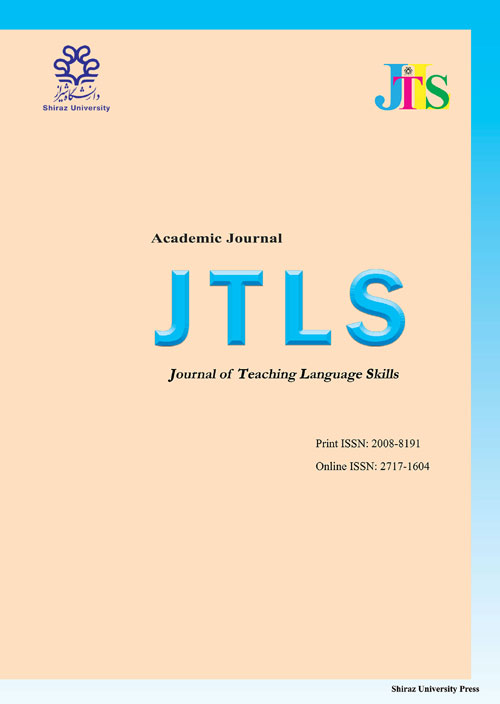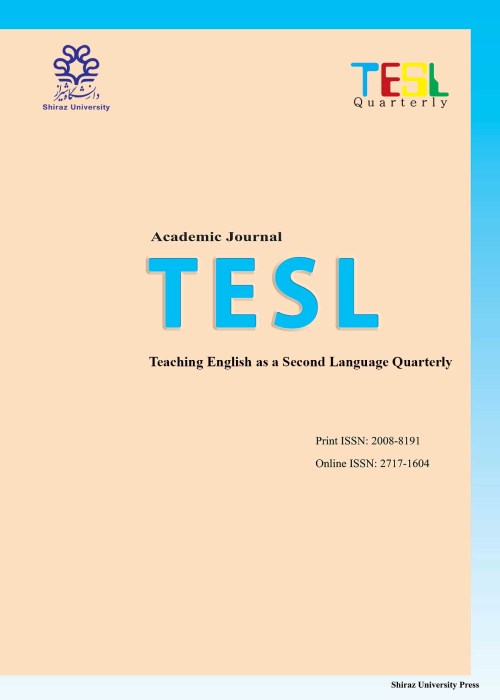فهرست مطالب

Teaching English as a Second Language Quarterly
Volume:39 Issue: 1, Spring 2020
- تاریخ انتشار: 1399/09/19
- تعداد عناوین: 6
-
-
Pages 1-44Since the establishment of the Islamic Republic of Iran, there have been three packages used in the state-controlled schools of the country, namely, Graded, Right Path to English, and Prospect/Vision series. These textbooks all include prefaces to indicate the general philosophy of language teaching and education, and how the agents (learners and teachers) have to play roles in the system. This article aims to have a postcolonial reading of the Islamic post-revolutionary English language textbooks published in Iran. To this aim, the prefaces are critically content-analyzed and explained taking into consideration the key concepts of postcolonialism. After developing the table of themes in relation to postcolonial issues, the findings indicate that the resistance prevalent in the prefaces is particularly hybrid, anxious, and unstable of the Iranian type due to the socio-politico-cultural background of the country. This resistance, thus, is a tragic attempt for developing a firm background for developing language learners'' knowledge.Keywords: postcolonialism, Graded, Right Path to English, Prospect, Vision, resistance, Bhabha
-
Pages 45-70Conducting qualitative research in applied linguistics seems to have some challenges. Hence, this study aimed to investigate the challenges of applied linguists across different research abilities to conduct qualitative studies. To that end, the biographical narratives, authored by 13 applied linguists, were collected. Then, the narratives were analyzed through qualitative data analysis principles, including organizing and familiarizing, coding and reducing, and interpreting and presenting (Ary et al., 2014). The findings showed that applied linguists face four challenges: methodological issues, technical issues, ethical issues, and qualitative research dissemination while doing qualitative research. The findings also indicated similarities and differences among applied linguists' challenges across different research abilities. It can be concluded that teaching qualitative research is more than mere lecturing about qualitative concepts. Thus, there should be practice-based instruction on qualitative research for applied linguistics students. Moreover, there should be a community for addressing pedagogical dialogs among applied linguists about doing qualitative research.Keywords: Qualitative Research, applied linguistics, research challenges, cross-sectional study
-
Pages 71-114This study examined the effects of input-oriented and output-oriented tasks with different involvement load indices on Iranian EFL learners' comprehension and production of lexical collocations. To achieve this purpose, a sample of 180 intermediate-level EFL learners (both male and female) participated in the study. The participants were in six experimental groups. Each of the groups was randomly assigned to one of the experimental conditions, namely input-oriented tasks with involvement load 1 (True-false), 2 (Matching), 3 (Multiple-choice), and output-oriented tasks with involvement load 1 (Short response), 2 (Fill in the blanks), and 3 (Sentence formation). At the end of the treatment period, the researchers administered a 40-item test in multiple-choice format and a 40-item test in fill-in-the-blanks format to assess the participants' comprehension and production of collocations. The collected data were analyzed using two different two-way ANOVAs and a series of independent-samples t-tests. The results showed that the tasks with higher involvement load indices were more effective on both receptive and productive knowledge of lexical collocations. The results also revealed that output-oriented tasks were more beneficial than input-oriented tasks at all three indices of involvement load. These findings can have theoretical and pedagogical implications for language teachers, researchers, and learners.Keywords: input-oriented tasks, involvement load, lexical collocations, output-oriented tasks
-
Pages 115-152
Foreign language enjoyment and speaking anxiety in the classroom are two potential emotion-inducing factors for foreign language learning. This sequential mixed methods study investigated whether and to what extent Iranian EFL students experienced foreign language enjoyment and public speaking anxiety in their English classrooms, and how they characterize the sources of the enjoyment and speaking anxiety in such a context. To these ends, 128 learners of English as a foreign language (EFL) from several English language institutes, selected based on convenience sampling, took part in this research. They completed Dewaele and MacIntyre’s (2014b) Foreign Language Enjoyment and Yaikhong and Usaha’s (2012) Public Speaking Class Anxiety questionnaires, and write down about an episode in which they had experienced enjoyment and speaking anxiety in the EFL classroom. Quantitative and qualitative statistical data analyses were applied to examine foreign language enjoyment and public speaking class anxiety. Descriptive data analysis showed that the learners had a medium-to-high foreign language degree of enjoyment and a low level of public speaking anxiety. Besides, they reported more enjoyment than public speaking anxiety in class. Further qualitative data analysis revealed 12 sub-themes and four main themes of Teacher, Learning, Class Activities, and Class Atmosphere in explaining their enjoyment, as well as eight sub-themes and four main themes of Exam Phobia, Reaction/Feedback, Personal Failure, and Lack of Self-Confidence for speaking anxiety. The findings provide implications for language teachers and policymakers to gain better insights into factors underlying enjoyment and speaking anxiety in the field of foreign language learning.
Keywords: EFL learners, EFL classroom, Foreign Language Enjoyment, Public Speaking Class Anxiety -
Pages 153-199There is substantial debate over the mental representation of regular past tense forms in both first language (L1) and second language (L2) processing. Specifically, the controversy revolves around the nature of morphologically complex forms such as the past tense –ed in English and how morphological structures of such forms are represented in the mental lexicon. This study focuses on the results of a speeded acceptability judgment task testing English regular past tense forms of high- and low frequencies. In this task, participants judged the acceptability of sentences as quickly and accurately as possible. Thirty-two intermediate-to-advanced L1 Persian and L1 Arabic speakers (L2ers) and twenty-two Native speakers (NSs) of English made acceptability judgments for regular past tense forms of high- and low-frequency verbs in sentential contexts. Considering participants’ reaction times (RTs) and accuracy rates as the dependent variables, the main results are as follows. Despite NSs’ faster RTs and higher accuracy scores, both groups demonstrated the same pattern of accuracy rates and RTs. Specifically, for accuracy data, regular verbs yielded a reverse frequency effect or anti-frequency effect in both groups (i.e., lower accuracy rates for high- than low-frequency regular forms in NSs as well as L2ers). For RT data, while the NSs exhibited a marginally anti-frequency effect, the L2ers displayed a nonsignificant trend for the anti-frequency effect. These results support the dual-mechanism models suggesting that the mental mechanisms and representations of inflectional morphology are the same in NSs and intermediate-to-advanced L2ers.Keywords: Dual-mechanism models, Frequency effect, mental representation, Regular past tense, Second language
-
Pages 201-252The present study aimed to review the instruction of the L2 speech acts in English pragmatics in the Iranian context during the last two decades from 2000 to 2020. To this end, upon the completion of the study search, the retrieved articles were selected and analyzed based on the research domain. The results of our synthesis from 54 studies carried out on the instruction of the speech act not only reveal that pragmatics is amenable to instruction but also unfold that the most frequently instructed speech act is the speech act of request which has been conducted in 29 studies, while the least instructed speech act is invitation, used in only one study. Moreover, analyzing the data collection methods documented that Multiple-choice Discourse Completion Test (MDCT) is the most predominant method utilized in 36 papers during the last decades in English pragmatic instruction. With respect to the treatment types, it is illuminated that the most recurrent treatment type is explicit, implicit vs. control, followed by explicit vs. implicit, although other treatment types have been embarked on. As a final point, it is worth noting that 53 of the conducted studies utilized the quantitative method in their data analyses, whereas only one study implemented the qualitative method. The paper concludes with some avenues for further research.Keywords: Pragmatics, instruction, speech acts, Systematic Review


